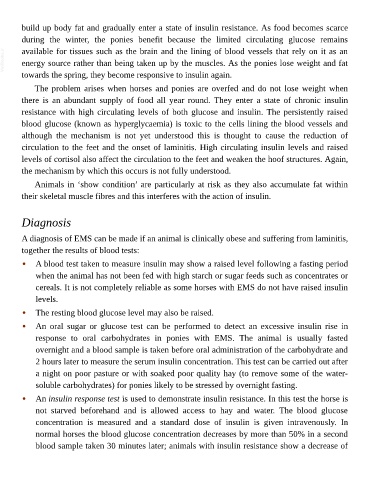Page 972 - The Veterinary Care of the Horse
P. 972
build up body fat and gradually enter a state of insulin resistance. As food becomes scarce
during the winter, the ponies benefit because the limited circulating glucose remains
VetBooks.ir available for tissues such as the brain and the lining of blood vessels that rely on it as an
energy source rather than being taken up by the muscles. As the ponies lose weight and fat
towards the spring, they become responsive to insulin again.
The problem arises when horses and ponies are overfed and do not lose weight when
there is an abundant supply of food all year round. They enter a state of chronic insulin
resistance with high circulating levels of both glucose and insulin. The persistently raised
blood glucose (known as hyperglycaemia) is toxic to the cells lining the blood vessels and
although the mechanism is not yet understood this is thought to cause the reduction of
circulation to the feet and the onset of laminitis. High circulating insulin levels and raised
levels of cortisol also affect the circulation to the feet and weaken the hoof structures. Again,
the mechanism by which this occurs is not fully understood.
Animals in ‘show condition’ are particularly at risk as they also accumulate fat within
their skeletal muscle fibres and this interferes with the action of insulin.
Diagnosis
A diagnosis of EMS can be made if an animal is clinically obese and suffering from laminitis,
together the results of blood tests:
• A blood test taken to measure insulin may show a raised level following a fasting period
when the animal has not been fed with high starch or sugar feeds such as concentrates or
cereals. It is not completely reliable as some horses with EMS do not have raised insulin
levels.
• The resting blood glucose level may also be raised.
• An oral sugar or glucose test can be performed to detect an excessive insulin rise in
response to oral carbohydrates in ponies with EMS. The animal is usually fasted
overnight and a blood sample is taken before oral administration of the carbohydrate and
2 hours later to measure the serum insulin concentration. This test can be carried out after
a night on poor pasture or with soaked poor quality hay (to remove some of the water-
soluble carbohydrates) for ponies likely to be stressed by overnight fasting.
• An insulin response test is used to demonstrate insulin resistance. In this test the horse is
not starved beforehand and is allowed access to hay and water. The blood glucose
concentration is measured and a standard dose of insulin is given intravenously. In
normal horses the blood glucose concentration decreases by more than 50% in a second
blood sample taken 30 minutes later; animals with insulin resistance show a decrease of

